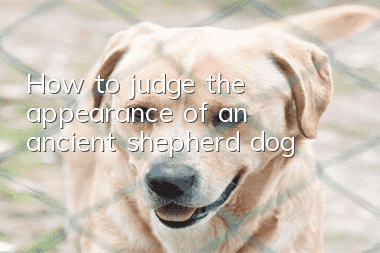How to judge the appearance of an ancient shepherd dog

Head: wide and preferably square, giving enough space to the brain (providing higher intelligence). The upper part of the eyes (above the eye sockets) is moderately arched. The entire head is covered with thick hair.
Eyes: brown, blue or one eye brown and one eye blue. If brown, the darker the better; blue, off-white, pewter or ring-shaped eyes are all typical. Amber or yellow eyes are not desirable.
Ears: Medium in size, flat on both sides of the head.
Stop: very clear
Jaw: Relatively long, strong, square and shortened. Note: A muzzle that is too long, narrow, or truncated is a deformity.
Nose: Black, large and broad.
Teeth: Strong, large, and even. The bite is either a pincer bite or a close scissors bite.
Neck: Relatively long, gently arched.
Topline: The withers are slightly lower than the loin, but there is no sign of weakness or laxity. NOTE: The topline is unique to this breed and distinguishes it from other breeds. Body: Preferably short and compact, with hips wider than shoulders, ribs well sprung, and chest deep and broad. It's neither a thick plate chest nor a barrel chest. The loin is very strong and slightly arched.
Prodromal: The scapula is tilted backwards and has a narrow tip. The forelegs are absolutely straight and of sufficient bone. The distance from the withers to the elbow is equal to the distance from the elbow to the ground.
Hind: round and muscular, with low hock position. When standing, the metatarsals are perpendicular to the ground from any angle.
Feet: small and round, with arched toes, thick and hard pads, and toes pointed straight forward.
Tail: Docked, the tail is cut off close to the body, so there is no natural swinging tail
The coat is very rich, but not so excessive that it makes it look fat. The texture is hard, not straight, but very fluffy. The quality and texture of your hair is more important than just the amount of hair. The undercoat is waterproof until trimmed and seasonally shed. There is moderate hair on the ears and the entire head is covered with hair. The neck is also heavily coated. There is hair all around the legs. The hair on the thighs and buttocks is thicker and longer than the hair on other areas, forming what is called a "jacket." The coat color is gray, off-white, blue or merle, with or without white markings (or vice versa).
It is docile and easy-going and can take care of children. It cannot tolerate high temperatures and should pay attention to preventing heatstroke. Because it is very independent, it needs strict training. It is a dog that is obedient even when punished. It is honest, reliable and trustworthy.Acting unnecessarily neurotic or aggressive.
- Is it better for Dogo dogs to have their ears erect or cropped? A case of Dogo dog’s ear erection surgery will tell you
- What do dogs eat to protect their stomach? It is important to protect their stomach and treat gastrointestinal diseases in dogs.
- How to tell if your dog is fat? Is your dog overweight?
- How to train Tibetan Mastiff Four aspects teach you how to train Tibetan Mastiff
- Will your dog catch a cold if you blow the air conditioner? What should you do if your dog catches a cold if you blow the air conditioner?
- What should you pay attention to when your dog drinks water? Don’t be careless when it comes to your dog’s drinking water.
- The dog's mouth bites and shakes. Why does the dog's mouth occasionally shake and bite?
- How to cut a dog's hair? Do you know how to cut a dog's hair correctly?
- Can dogs eat raw eggs? Why can’t dogs eat egg whites?
- Common Dog Problems in Summer How to Deal with Different Dog Problems



